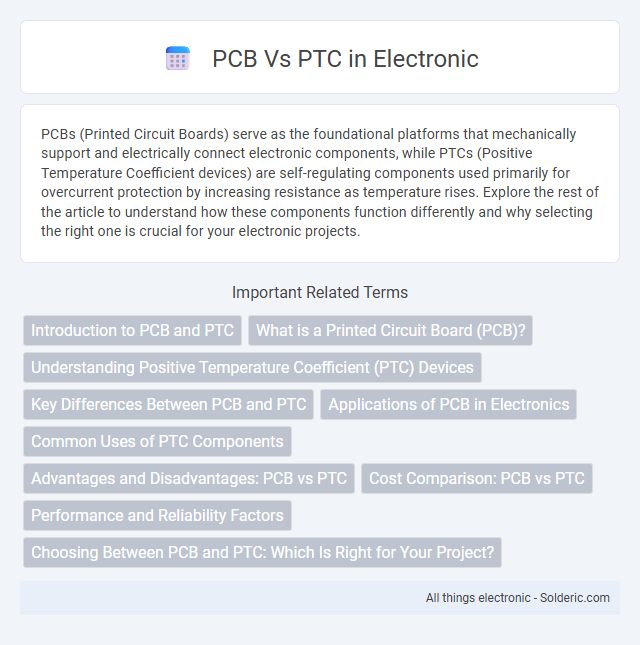PCBs (Printed Circuit Boards) serve as the foundational platforms that mechanically support and electrically connect electronic components, while PTCs (Positive Temperature Coefficient devices) are self-regulating components used primarily for overcurrent protection by increasing resistance as temperature rises. Explore the rest of the article to understand how these components function differently and why selecting the right one is crucial for your electronic projects.
Comparison Table
| Feature | PCB (Printed Circuit Board) | PTC (Positive Temperature Coefficient) |
|---|---|---|
| Definition | Electrically insulating board used to mechanically support and electrically connect electronic components. | Resistor type whose resistance increases with temperature, used for overcurrent protection. |
| Function | Facilitates circuit assembly and connectivity. | Protects circuits by limiting current during overheating. |
| Material | Fiberglass, epoxy resin, and copper layers. | Ceramic or polymer material exhibiting positive temperature coefficient. |
| Application | Used in all electronic devices for component integration. | Used as resettable fuses in power supplies, chargers, and electronics. |
| Component Type | Physical platform and connector for components. | Active protective electronic component. |
| Key Benefits | Compact, reliable circuit interconnection. | Automatic current limiting, resettable, improves safety. |
Introduction to PCB and PTC
Printed Circuit Boards (PCBs) are essential components in electronics, providing mechanical support and electrical connections through conductive pathways etched from copper sheets laminated onto a non-conductive substrate. Positive Temperature Coefficient (PTC) devices, often used as resettable fuses or temperature sensors, increase resistance as temperature rises, protecting circuits from overcurrent or overheating. Both technologies are fundamental in modern electronic design, where PCBs form the structural foundation and PTC components ensure safety and reliability by managing thermal and electrical stresses.
What is a Printed Circuit Board (PCB)?
A Printed Circuit Board (PCB) is a flat, insulating substrate designed to mechanically support and electrically connect electronic components using conductive pathways, tracks, or signal traces etched from copper sheets laminated onto the substrate. PCBs serve as the foundational platform for most electronic devices, enabling compact and organized assembly of components such as resistors, capacitors, and integrated circuits. Their design and manufacturing precision directly impact signal integrity, heat dissipation, and overall device performance.
Understanding Positive Temperature Coefficient (PTC) Devices
Positive Temperature Coefficient (PTC) devices are specialized components that increase their resistance as temperature rises, providing self-regulating heating and overcurrent protection in electronic circuits. Unlike Printed Circuit Boards (PCB), which serve as platforms for mounting and interconnecting electronic components, PTC devices actively respond to thermal changes to prevent damage and enhance safety. Their unique temperature-dependent properties make them essential in applications such as resettable fuses, motor protection, and temperature sensing systems.
Key Differences Between PCB and PTC
Printed circuit boards (PCBs) are rigid or flexible boards used to mechanically support and electrically connect electronic components through conductive pathways. Positive temperature coefficient (PTC) devices are polymer-based resistors that increase resistance as temperature rises, serving as self-regulating heaters or overcurrent protectors. The key differences between PCB and PTC lie in their primary functions: PCBs provide structural and electrical interconnection for circuits, while PTCs act as protective or heating components responding to temperature changes.
Applications of PCB in Electronics
Printed Circuit Boards (PCBs) are essential in electronics, serving as the foundational platform for mounting and interconnecting electronic components in devices like smartphones, computers, and industrial machines. Their versatility enables compact and reliable circuitry for consumer electronics, medical devices, and automotive systems. PCBs optimize signal integrity and power distribution, making them crucial for high-performance electronic applications.
Common Uses of PTC Components
PTC components are commonly used in overcurrent protection, self-regulating heating elements, and resettable fuses in electronic circuits. Their unique positive temperature coefficient property makes them ideal for safeguarding devices by limiting current during fault conditions. Industrial applications include motor protection, power supplies, and temperature sensors.
Advantages and Disadvantages: PCB vs PTC
Printed Circuit Boards (PCBs) offer high reliability, cost-effectiveness in mass production, and compact design but can be expensive for small runs and challenging to modify once manufactured. Positive Temperature Coefficient (PTC) devices provide self-regulating overcurrent protection and resettable functionality without the need for replacement, but they have slower response times and limited current capacity compared to traditional fuses. Choosing between PCB and PTC depends on application requirements such as circuit complexity, protection needs, and maintenance considerations.
Cost Comparison: PCB vs PTC
Printed Circuit Boards (PCBs) generally incur lower manufacturing costs due to standardized mass production and widespread availability, making them more economical for high-volume electronic device fabrication. Positive Temperature Coefficient (PTC) thermistors, while relatively inexpensive per unit, can increase overall system costs when integrated within protective circuits due to additional components and design complexity. For cost-sensitive applications, PCBs offer a more budget-friendly solution, whereas PTCs provide targeted overcurrent protection with a potentially higher initial investment.
Performance and Reliability Factors
PCB (Printed Circuit Board) performance depends heavily on materials like FR4 or polyimide, affecting thermal stability and signal integrity, while PTC (Positive Temperature Coefficient) devices offer inherent self-regulating current characteristics that improve circuit protection and reliability. PCB reliability is influenced by factors such as copper thickness, trace width, and layer count, which affect current capacity and heat dissipation; PTC reliability stems from consistent resistance increase under overcurrent conditions, preventing damage from thermal runaway. High-performance PCBs prioritize dielectric constant and loss tangent for high-frequency applications, whereas PTC elements excel in safeguarding sensitive components against electrical faults by providing automatic resettable protection.
Choosing Between PCB and PTC: Which Is Right for Your Project?
Choosing between PCB (Printed Circuit Board) and PTC (Positive Temperature Coefficient) components depends on your project's specific requirements for circuit protection and thermal management. PCBs provide a versatile platform for designing and interconnecting electronic components, while PTC devices serve as resettable fuses that protect circuits from overcurrent conditions. Understanding the electrical load, environmental factors, and safety standards of your project ensures you select the most effective solution.
PCB vs PTC Infographic

 solderic.com
solderic.com